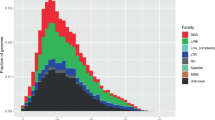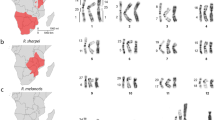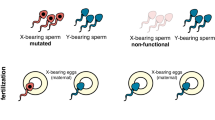Abstract
T(Y − D1)35 is a genetic sexing line in Anopheles stephensi (2n = 6; XX♀, XY♂) based on the translocation of the dieldrin resistance gene to the male determining chromosome. A cytological analysis demonstrated the presence of a 3 chromosome multiple translocation in which part of the Y chromosome formed the differential segment. An analysis of egg karyotypes enabled the segregation behaviour of the complex to be determined and only alternate and adjacent I segregations could be demonstrated. The breakpoint of the translocation in chromosome 3 was located using polytene salivary gland preparations. Linkage studies using chromosome three markers revealed contrasting effects of the translocation on recombination in this chromosome. An insecticide treatment method, based on the exposure of newly emerged adults, was developed enabling large numbers of individuals to be treated for the production of only males.
Similar content being viewed by others
Article PDF
References
Ahktar, K, Sakai, R K, and Baker, R H. 1982. Linkage group III in the malaria vector, Anopheles stephensi. J Hered, 73, 473–475.
Bailey, D L, Lowe, R E, Dame, D A, and Seawright, J A. 1980. Mass rearing the genetically altered MACHO strain of Anopheles albaminus Wiedemann. Amer J Trop Med Hyg, 29, 141–149.
Baker, R H, Sakai, R K, and Raana, K. 1981. Genetic sexing for a mosquito sterile-male release. J Hered, 12, 216–218.
Curtis, C F. 1978. Genetic sex separation in Anopheles arabiensis and the production of sterile hybrids. Bull WHO, 56, 453–454.
Curtis, C F, and Robinson, A S. 1971. Computer simulation of the use of double translocations for pest control. Genetics, 69, 97–113.
Curtis, C F, Akiyama, J, and Davidson, G. 1976. A genetic sexing system in Anopheles gambiae species A. Mosq News, 36, 492–498.
Foster, G G, Whitten, M S, Vogt, W G, Woodburn, T L, and Arnold, S T. 1978. Larval release method for genetic control of the Australian sheep blowfly, Lucilia cuprina (Wiedemann) (Diptera: Calliphoridae) Bull ent Res, 68, 75–83.
French, W L, Baker, R H, and Kitzmiller, J B. 1962. Preparation of mosquito chromosomes. Mosq News, 22, 377–383.
Heemert, C Van, Toan, T A, Robinson, A S, and Feld Mann, A. 1983. Induction and isolation of translocations in Anopheles stephensi. Mosq News, 43, 480–484.
Lines, J, and Curtis, C F. 1985. Genetic sexing systems in Anopheles arabiensis Patton. J econ Entomol, 78, 848–851.
Malcolm, C. Genetic analysis of reduced susceptibility to knockdown by permethrin and its relationship to DDT resistance in larvae of Anopheles stephensi. Bull Ent Res (submitted),
McDonald, P T, and Asman, S M. 1982. A genetic sexing strain based on malathion resistance for Culex tarsalis. Mosq News, 42, 531–536.
McDonald, P T, and Rai, K S. 1970. Aedes aegypti: Origin of a “new” chromosome from a double translocation heterozygote. Science, 168, 1229–1230.
Parvez, S D, Akhtar, K, and Sakai, R K. 1985. Two new mutations and a linkage map of Anopheles stephensi. J Hered, 76, 205–207.
Roberts, P A. 1976. The genetics of chromosome aberration. Ashburner, M. and Novitski, E. (eds.), In The Genetics and Biology of Drosophila, 1a, Academic Press Inc. (London) Ltd, p. 486.
Robinson, A S. 1983. Sex-ratio manipulation in relation to insect pest control. Annu Rev Genetics, 17, 191–214.
Robinson, A S. 1986. Genetic sexing in Anopheles stephensi using dieldrin resistance. J Amer Mosq Cont Assoc, 2, 93–95.
Robinson, A S, Malcolm, C, Mali, P, and Schelling, G. 1986. Breakpoint distribution in male-linked translocations in Anopheles stephensi Liston. J Hered In press.
Rowland, M. 1985. Location of the gene for malathion resistance in Anopheles stephensi (Diptera: Culicidae) for Pakistan. J Med Entomol, 22, 373–380.
Sakai, R K, and Mahmood, F. 1985. Homozygous chromosomal aberrations in Anopheles stephensi, J Hered, 76, 230–236.
Sakai, R K, Baker, R H, Raana, K, and Hassan, M. 1979. Crossing-over in the long arm of the X and Y chromosomes in Anopheles culicifacies. Chromosoma, 14, 204–218.
Sakai, R K, Mahmood, F, Akhtar, K, Dubash, C T, and Baker, R H. 1983. Induced chromosomal aberrations and linkage group-chromosome correlation in Anopheles stephensi. J Hered, 14, 232–238.
Seawright, J A, Kaiser, P E, Dame, D A, and Lofgren, C S. 1978. Genetic method for the preferential elimination of females of Anopheles albimanus. Science, 220, 1303–1304.
Sharma, G P, Parshad, R, Narang, S L, and Kitzmiller, J B. 1969. The salvary chromosomes of Anopheles stephensi. J Med Entomol, 6, 68–71.
Vosselman, L, and Van Heemert, C. 1980. Meiotic disjunction and embryonic lethality in sex-linked double-translocation heterozygous males of the onion fly, Hylemya antiqua (Meigen). Theoret appl Genet, 58, 161–167.
Author information
Authors and Affiliations
Rights and permissions
About this article
Cite this article
Robinson, A., Van Lap, P. Cytological, linkage and insecticide studies on a genetic sexing line in Anopheles stephensi Liston. Heredity 58, 95–101 (1987). https://doi.org/10.1038/hdy.1987.14
Received:
Issue date:
DOI: https://doi.org/10.1038/hdy.1987.14



